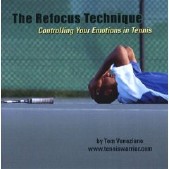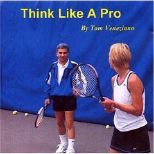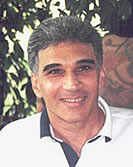January 2017 Article
Get Tom Veneziano's book The Truth about Winning! at Amazon.com
Tennis Server
|

 |
In high-level tennis, even when a tennis ball is hurtling toward the pro at 80 to 130 miles an hour, to him (or her) the ball appears much slower. Not only that, but the ball can seem as big as a basketball! How does this strange phenomenon happen? Can the same happen for you? Yes it can, and it will bring more benefits to your game than you think. "If you want to go about this systematically use a ball machine. Every time you fill up the hopper, turn up the speed a little. It's amazing how even over the course of an hour the eyes/mind/body reacts. Balls that seemed fast at the start now are slower than routine. Keep it up over a period of weeks and the difference is amazing. Keep it up for years at 3,000 balls a day and you have Agassi's boyhood training mechanism under his crazy dad's instruction." The bottom line is that intensive training with many different speeds and trajectories will help you begin to see the ball slow down. Now here is the best part, the added benefit I mentioned earlier: Seeing the ball slow down has a direct connection to increasing your options in match play. John McEnroe gets this right when he says, "Things slow down, the ball seems a lot bigger and you feel like you have more time. Everything computes - you have options, but you always take the right one." You have more options! You begin to see a more complete picture of the court in the middle of a point, allowing you to clearly note where your opponent or opponents are positioned. You can intuitively sense and find openings to place the ball. You even begin to anticipate where your opponents will hit the ball. Obviously, these new options are a huge advantage! But why do they emerge around the same time the ball starts to slow down for you? Why were these skills not developed before? I'm sure many coaches have told you to hit to the open court, to notice where your opponents are positioned and to anticipate certain shots. Why didn't you just do it? The answer is, you couldn't. If the ball was not yet slowed down for you, executing those tasks all at once was practically impossible. This is because your unconscious mind was completely consumed with its job of analyzing what appeared to be a fast-moving ball. There was no room to fit all those other informational skills into the overtaxed unconscious. However, once you reach the level where the ball has slowed down, your unconscious mind is ready to do some multi-tasking. No longer overburdened, the unconscious mind automatically begins to detect the movement of your opponents, their shot selection, and any court openings. As a result of a more efficient unconscious mind, you instinctively sense all kinds of action on the court that you previously found impossible to see! Do you remember my telling you in other newsletters that with enough repetition you will develop your tennis game through self-discovery? Well, the ball slowing down is an example of a skill learned from repetition and self-discovery. All you have to do is put yourself on automatic and keep swinging and swinging and swinging. One day you will notice that the ball seems to hang in the air just a bit longer. After that, new options open up and new skills emerge. This will all happen automatically. Stay with the intense practice, give your unconscious mind enough time to learn and pro-like sensations can be yours!
This column is copyrighted by Tom Veneziano, all rights
reserved.
Tom is a tennis pro teaching
at the Piney Point Racquet Club in Houston, Texas. Tom
has taught thousands of players to think like a pro with
his Tennis Warrior System.




Audio CDs by Tom Veneziano:
|



October 2022 Tennis Anyone: Patterns in Doubles by John Mills. September 2022 Tennis Anyone: Short Court by John Mills. |

 You will join 13,000 other subscribers in receiving news of updates to the Tennis Server along with monthly tennis tips from tennis pro Tom Veneziano.
You will join 13,000 other subscribers in receiving news of updates to the Tennis Server along with monthly tennis tips from tennis pro Tom Veneziano. 